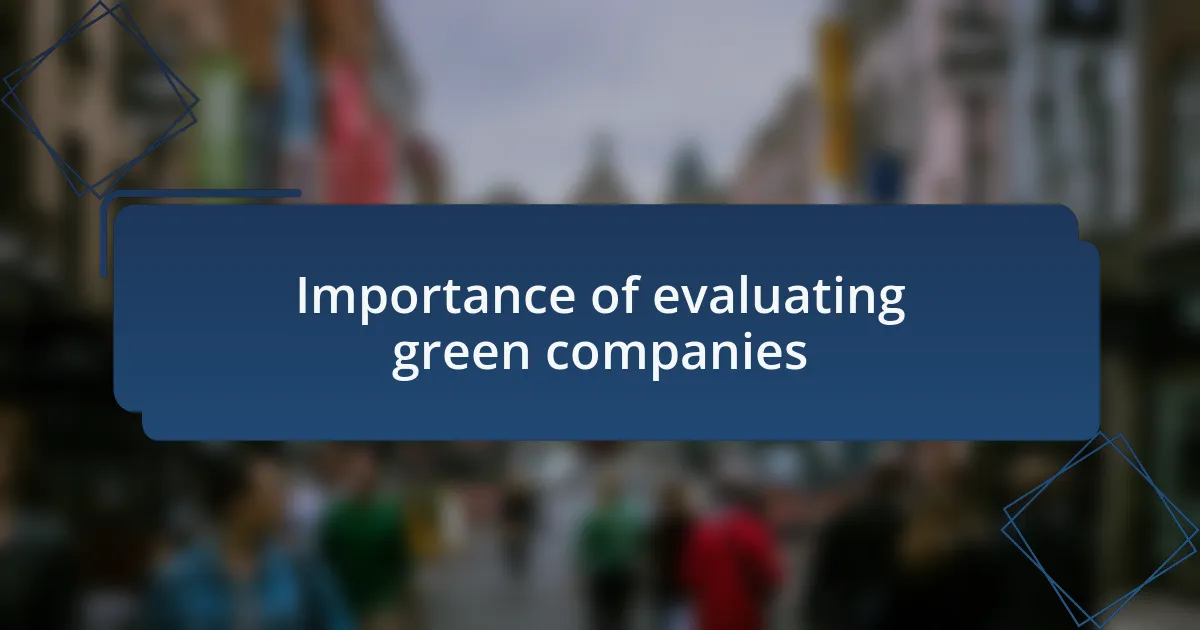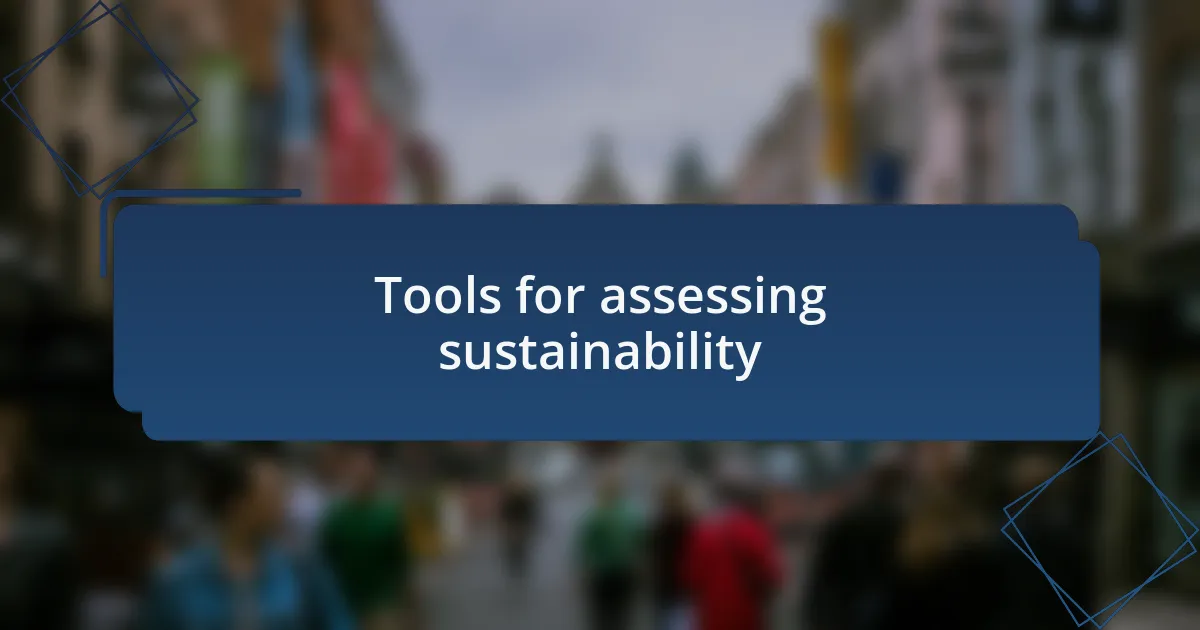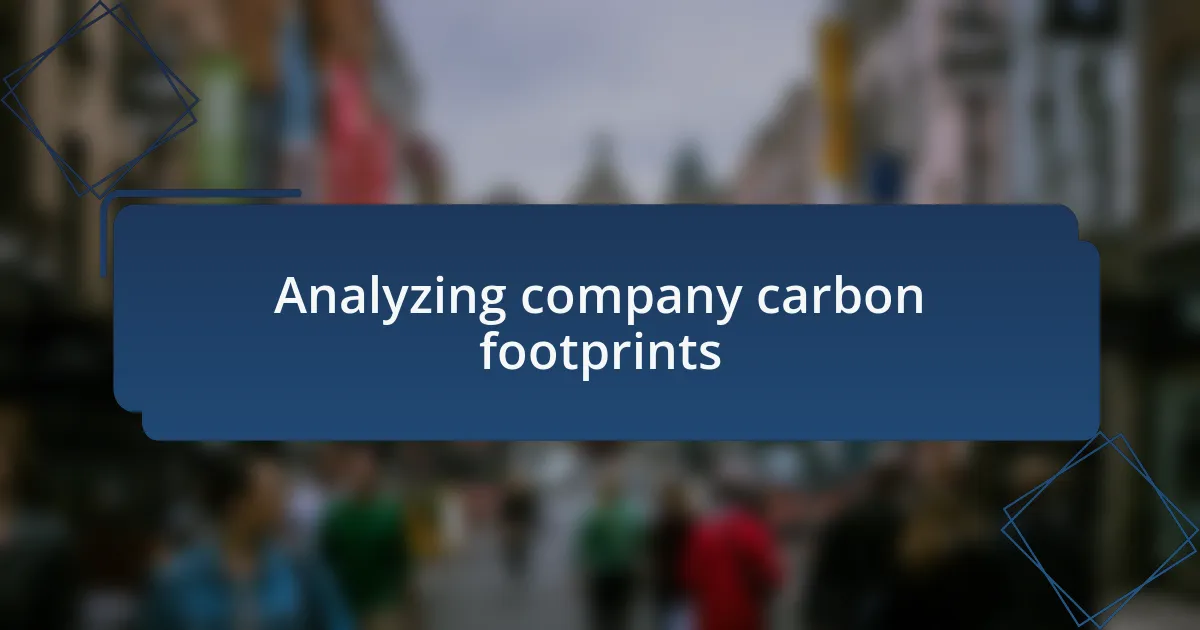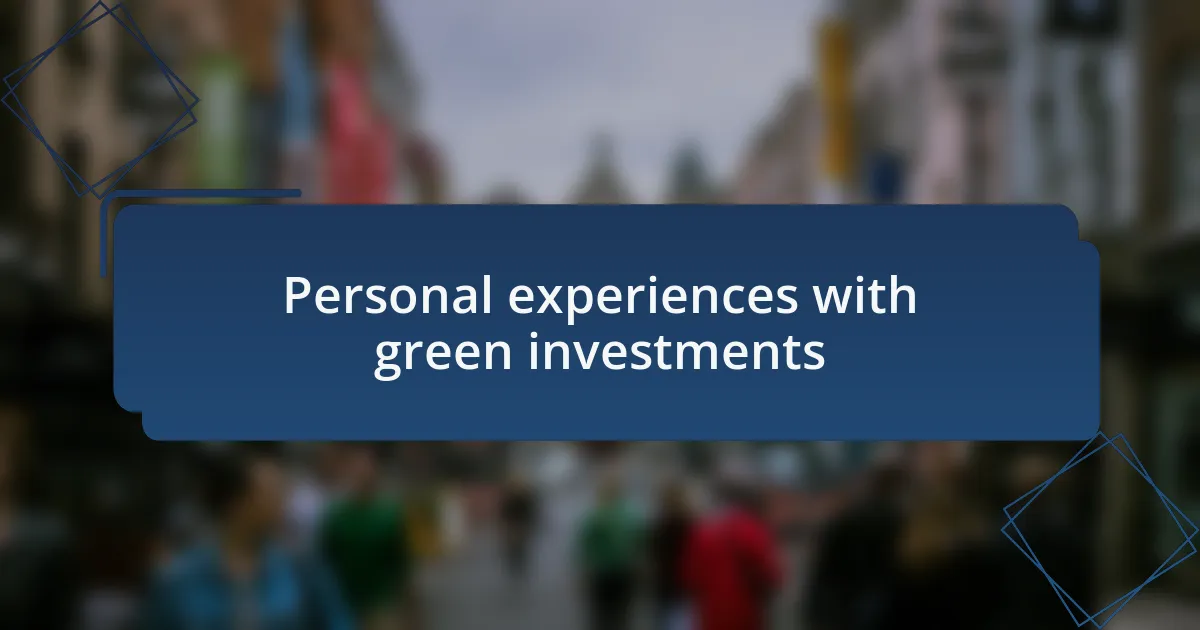Key takeaways:
- Eco-friendly finance involves supporting sustainable businesses and influences corporate behavior towards greener practices.
- Evaluating green companies is essential to distinguish genuine sustainability efforts from greenwashing and align investments with personal values.
- Tools like Global Reporting Initiative standards and sustainability scorecards aid in assessing a company’s true environmental impact.
- Engaging with investment communities enhances understanding and promotes informed decision-making in eco-friendly investments.

Understanding eco-friendly finance
Eco-friendly finance represents more than just a funding mechanism; it embodies a commitment to sustainable practices. I often reflect on my own experiences, where I chose to support businesses emphasizing eco-responsibility, and it feels gratifying to know my choices contribute to a healthier planet. Think about it: when you invest in these green companies, you’re not only seeking financial returns but also championing a cause that aligns with your values.
There’s a notable shift in the financial landscape towards integrating environmental criteria into decision-making processes. I remember reviewing my investment portfolio and feeling a sense of pride when I noticed how many companies prioritize sustainability. It’s heartening to realize that the choices we make in finance can indirectly influence corporate behavior, pushing more companies to adopt greener practices.
Moreover, understanding eco-friendly finance goes beyond just choosing green stocks. I’ve often pondered the question: How can we ensure our money works for us and the environment? By exploring various green investment options, such as renewable energy funds or sustainable agriculture initiatives, we can create a portfolio that not only yields profits but also nurtures a sustainable future.

Importance of evaluating green companies
Evaluating green companies is crucial because it shapes our understanding of what “sustainable” truly means. I recall a time when I invested in a promising sustainable tech firm, only to later discover their practices were less than eco-friendly. This experience taught me the importance of digging deeper; knowing how a company operates behind the scenes can significantly impact both the planet and my portfolio.
Moreover, assessing these companies helps distinguish between genuine eco-friendly efforts and greenwashing, where firms market themselves as sustainable without substantial action. When I encounter brands showcasing impressive environmental claims, I often find myself asking: Are they backing this up with real initiatives? This questioning not only safeguards my investments but also empowers me to support businesses that genuinely contribute to a sustainable future.
Lastly, evaluating the green credentials of companies allows us to align our financial choices with our ethical beliefs. I vividly remember shifting my funds from a company that was misleading in its environmental practices to one that truly prioritized sustainability. This decision was liberating, reinforcing my conviction that our investments should reflect our values and commitment to a greener planet.

Tools for assessing sustainability
To assess sustainability effectively, various tools and metrics can help streamline the evaluation process. One such tool is the Global Reporting Initiative (GRI) standards, which provide a comprehensive framework for companies to disclose their sustainability performance. I once explored a company’s GRI report, and it opened my eyes to the level of transparency I should expect. It highlighted not just their environmental impact but also their social and economic responsibilities.
Another useful method is the use of sustainability scorecards. These scorecards often break down a company’s performance into different metrics like energy use, waste management, and community engagement. I remember analyzing a local business with a scorecard, and it was enlightening to see how they ranked in multiple categories. It not only helped me make an informed choice but also allowed me to engage with their team, asking deeper questions about their practices.
Finally, third-party assessments, such as those provided by organizations like Sustainalytics, can serve as a valuable resource. These ratings, which evaluate the environmental and social practices of companies, can guide investors away from firms that may not have ethical foundations. When I first came across these ratings, I felt a mix of skepticism and hope. Skepticism about whether these ratings were trustworthy, but hope because they offered a way to simplify my decision-making while aligning it with my values.

Analyzing company carbon footprints
When evaluating a company’s carbon footprint, I find it crucial to look beyond just their emissions data. It’s fascinating how some companies boast of low carbon outputs on paper but fail to account for indirect emissions in their supply chain. I once encountered a brand proudly advertising their low emissions, yet after deeper research, I discovered that their suppliers were contributing significantly to their overall footprint. This revelation made me wonder: how transparent are companies really about their environmental impact?
It’s also important to consider the methodologies used in measuring carbon footprints. Some companies utilize life cycle assessments (LCAs), which calculate emissions from raw material extraction to product disposal. The first time I analyzed a company with an LCA, I was struck by how much their emissions varied at different stages of production. It made me realize that understanding these nuances is key to forming a complete picture of a company’s environmental responsibility.
Moreover, tracking a company’s progress over time is essential. I remember taking note of a tech company that had committed to reducing its carbon footprint year-over-year. Monitoring their public reports became a bit of a personal project for me. It felt rewarding to see them meet their targets and even exceed some of their goals. This not only bolstered my confidence in supporting them but also raised an interesting question: how can we hold other companies accountable to similar standards?

Personal experiences with green investments
When I first ventured into green investments, I was hesitant about the potential risks. I distinctly remember my initial investment in a renewable energy company. It was exhilarating to see my money support solar initiatives, but at times I wondered if my investment would really make a difference. The excitement of seeing tangible change—like better energy solutions in communities—reassured me that I was on the right path.
There was a moment that really stood out during my green investment journey. I attended a shareholder meeting for a sustainable fashion brand I had invested in. Seeing the passion from their team and the stories of impact shared by local communities was incredibly moving. It made me reflect on how every dollar invested could lead not just to profits but to positive social change. I began to question how many investors share this kind of connection with their investments.
As I became more experienced, I learned to trust my instincts about companies that genuinely prioritized sustainability. I recall pulling out from a tech firm after I discovered they were maintaining outdated practices under the guise of being eco-friendly. It made me wonder: how often do we overlook the signs when a company’s commitment to sustainability feels more like greenwashing? Now, I approach each investment with a keen eye, blending research with my values to make choices that align with my principles.

Tips for making informed choices
When I evaluate green companies, I often start by diving deep into their environmental, social, and governance (ESG) practices. For instance, I once spent hours reading a small eco-tech company’s sustainability report. It was enlightening to see how transparent they were about their supply chain and energy consumption. How many companies provide such clarity? This level of openness often signals a genuine commitment to sustainability.
Another tip is to look beyond catchy green labels. I vividly recall a time I was swayed by a company’s “green” branding only to discover their production processes were far from sustainable. This experience taught me the importance of digging deeper; I now verify certifications like Fair Trade or Energy Star when assessing companies. Have you ever felt misled by marketing buzzwords? I have, and it reinforced the need for critical evaluation when making investment choices.
Finally, I recommend connecting with communities or forums focused on eco-friendly investments. I recall joining a local green investment group where we shared our experiences and tips. Hearing different perspectives challenged my views and made me more discerning. Engaging in such discussions not only enriches my understanding but also sparks further reflection about the true impact of my investments. Isn’t it empowering to be part of a broader conversation about sustainability?